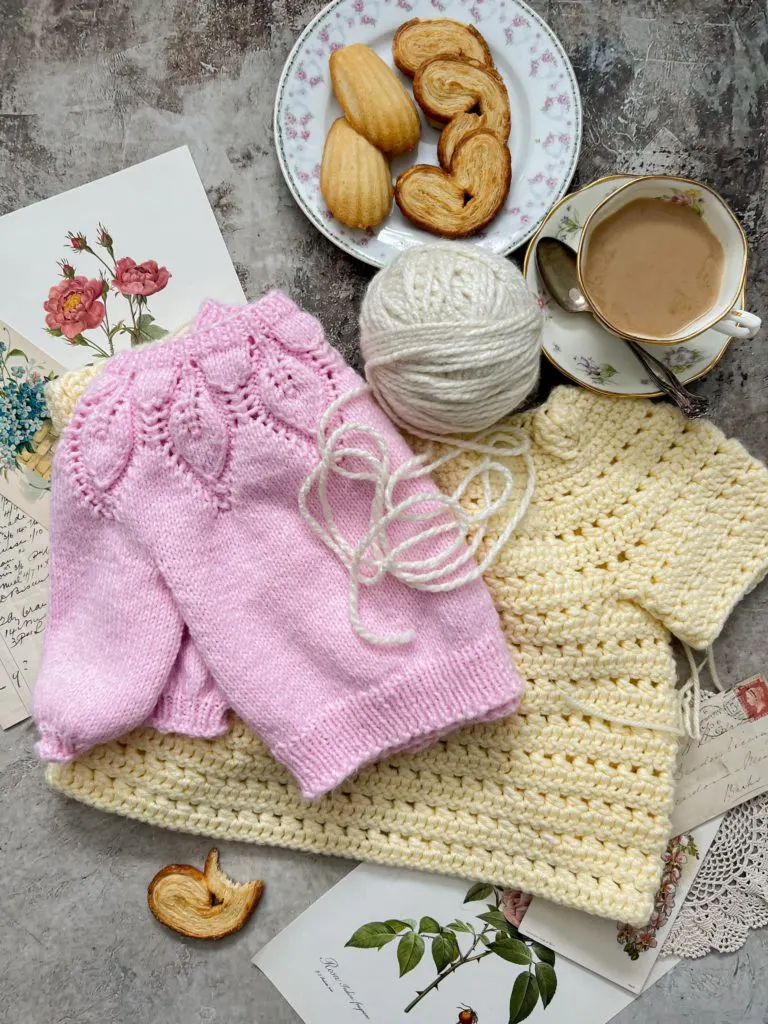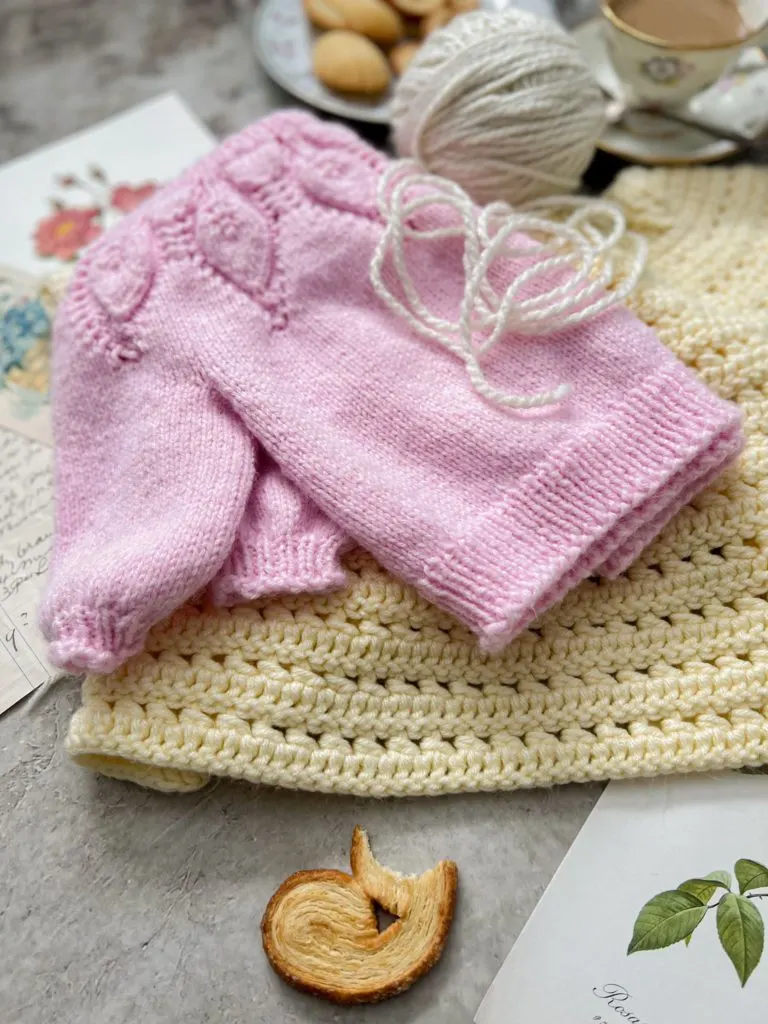Most of the time, I like to knit with natural fibers. There’s a whole host of reasons for that, which we can get into later, but I want to make sure one thing is very clear here: acrylic yarn has a place in my stitching life, too.

Now, there are absolutely reasons you might choose to avoid acrylic yarns for yourself. They have a negative environmental impact, they aren’t great for moisture-wicking, and they can have a kind of odd, squeaky texture while you’re working with them. These are valid concerns.
But knitters have a bad reputation for being incurable yarn snobs, too, and for making others feel unwelcome when those other knitters are using acrylics. I have no time or patience for that. It’s one thing to choose only natural fibers for yourself, but it’s another thing altogether to sneer at other knitters for making different choices.
We don’t do that here.
The wool vs. acrylic yarn debate has raged for ages, and I’m not under any illusions we’ll solve it here in this one blog post. The truth is, there are all sorts of perfectly valid reasons to choose an acrylic yarn.
Here are some of the reasons that I sometimes decide acrylic is the right choice for my project.
Acrylic yarn is easy to care for.
Sometimes, I’ll choose acrylic yarn for a project that I know will get a lot of use or that will need to be washed regularly. If I’m knitting for my kid or making a blanket, nine times out of ten, I’ll be using a yarn that is primarily or entirely made of synthetic fibers.
That’s because it’s absolutely true that acrylic yarn is easier to care for than most animal fibers. I can throw those projects in the washer and dryer without worrying. There’s no stressing about felting in the wash. I don’t have to lay things flat to air dry. I just wash and go.
And when I’m caring for little sweaters covered in PB&J remnants or blankets that regularly get used when someone is sick, that ease of care is a big deal.

Also, if I’m honest, I’m pretty forgetful. I try to be careful, but I’ve felted knits on accident before (RIP, my beloved Berry Scone Shawl). While knits for myself don’t need to be washed often, so I can minimize the risk of forgetting they’re involved in the laundry, household knits and knits for my kid need a little more frequent laundering.
It can be less stressful for the recipient.
I don’t knit gifts often, again for a whole host of reasons, but when I do, I always check with the recipient about their fiber preferences.
Sometimes they don’t care. Sometimes they’re fine with a natural fiber for a special item but would prefer synthetics for everyday wear. Sometimes they have a strong preference for one or the other.
And whatever the recipient wants, that’s the fiber I use.
Often, when I make baby gifts, the new parents tell me they’re too worried about taking care of handknits made with fancy yarns. In those cases, I’ll often use acrylic to help cut down on the stress for them. They’ve got enough on their plates without worrying about whether they’re going to ruin something I’ve spent 12 hours making.
That’s a driving force behind my gift knitting philosophy, and something we’ll have to explore here soon. Ultimately, a gift that makes work (even emotional work) for the recipient isn’t much of a gift.
Acrylic yarn can be less expensive.
There’ve been times in my knitting journey where there wasn’t a ton of spare room in the budget. I economized in lots of places, and yarn choices were an easy way to do that. Acrylic yarns tend to be less expensive than most wool yarns (though this isn’t an absolute, and if you want to use wool, don’t let budget scare you away!).

Even now, when finances are less of a concern, I’ll sometimes opt for acrylic for a very large project. If I’m going to be using 2,000 yards of yarn or more, that can get pretty pricey pretty fast, even with budget wools.
In that scenario, an acrylic yarn is one way to help control the cost.
It’s easily accessible.
I grew up in a town that, while not small, didn’t have a lot of fancy amenities. I had never heard of a local yarn shop until I was in my 20s.
So it will probably not surprise you to learn that I grew up working with acrylic yarn. It was what we had available, and it was abundant. My friends and I made blankets for our dolls and experimented with weaving on toy looms. Acrylic yarn helped our imaginations grow.
Nowadays, I’m back in that hometown, and while it has changed quite a bit, the nearest dedicated LYS is still 40 minutes to an hour away (depending on traffic). I’ve got a small kid and not a ton of spare time, and sometimes I just need to pop into the store to get an extra skein of yarn to finish a project.
It’s nice to be able to just walk into a big box craft store and pick up what I need.
Pests generally don’t eat acrylic yarn.
Moths, carpet beetles, and silverfish are the bane of those of us who like to work with animal fibers. There’s nothing worse than opening up a hank of yarn, only to find the telltale splitty signs that show some little critter has been munching on it.
It’s even worse to find those telltale signs in a finished project we’ve spent hours working on.

There are, of course, things you can do to help cut down on the possibility of creepy crawlies getting into your animal fibers. You can use cedar sachets, regularly air and rotate your wool, be sure to wash garments before storage, and more. Plenty of knitters never have a pest problem.
But you can also avoid the problem by using a material that pests won’t want to snack on.
Acrylic is a synthetic material (essentially, plastic), which isn’t exactly great for any digestive system, even an insect’s. As a result, they don’t tend to nibble on acrylic yarn (though if you put your knits away for an extended period of time after you’ve worn them, and you don’t wash them beforehand, critters can still be drawn to sweat, body oils, and dropped bits of food left behind on the garment). While there are other concerns involved in using a synthetic fiber and there are lots of considerations to weigh when choosing wool vs. acrylic yarn, this is certainly a benefit.
Acrylic can be soft and pleasant against the skin.
Some knitters are concerned about using acrylic yarns because they’re haunted by memories of scratchy acrylics that feel rough in the skein and even worse against the hands. Those yarns are definitely still out there, but modern acrylics have a wider range of quality and textures.
A high quality acrylic yarn can feel wonderfully soft against the skin, which can be a good thing if you’re knitting for somebody with sensitive skin who also can’t wear animal fibers for whatever reason. While you may still have some issues with acrylic’s breathability and absorption, a good quality acrylic won’t feel scratchy.
Ultimately, every knitter has to balance and evaluate their own needs and priorities when making fiber choices. There are so many factors that go into the yarns we choose, and that’s okay! Each of us is on our own knitting journey.
But as for me and my knits, there will always be room for a bit of acrylic in there. After all, if I don’t use it right away, it’ll keep.
How about you? Drop me a note in the comments and let’s chat about fiber content.
Sandy
Monday 20th of November 2023
Thank you so much for acknowledging that acrylic yarns do indeed have their place. Being a homesteader, most of my clothes are going to be worn while doing chores that guarantee they’ll get dirty and smelly. And while I do have some nice sweaters I’ve made using wool, I save them for special occasions. Gifts are always done using acrylic (unless specifically requested in a natural fiber) for stress-free care on the recipients end - especially if it’s for a baby or young child! I also find cotton and bamboo nice for household items and summer knits. But by and large acrylic yarns are just so much more suitable for my lifestyle.
Cindy Ashton
Thursday 26th of January 2023
I learned to knit from my mother,, grandmother and godmother as a child. I grew up with acrylic yarn especially Red Heart. And still use it for my Christmas stockings for children. Easily washable, too. Then Lion Brand, Caron, and Vanna yarns. And later as I got my own working jobs expanded out into more wools and other natural fiber yarns. I love working alpaca, llama, bamboo, silk, and Yak wool blend yarns, too. You hit on all the reasons that I still work with acrylic yarn in the past and present, too. Depends on the project which type of yarn I work with.
Lauren Rad
Saturday 4th of February 2023
I'm so glad this resonated with you and your experience. So many of us start out with acrylics for various reasons, branch out into other fibers, but still find uses for the synthetic yarns in certain situations.
Mary
Tuesday 10th of January 2023
I knit all types of yarn. Plus I love that pink sweater in this blog. Would love the sweater in adult sizes.
Lauren Rad
Tuesday 10th of January 2023
Isn't it a darling little thing? And it looks like there is an adult version, too, though the size range is not what I'd hope for: https://www.ravelry.com/patterns/library/chunky-dahlia-solo
nathalie
Wednesday 14th of September 2022
I was a yarn snob for years until i found the pure wool fair isle scarf i had knitted for my dead brother (and that i kept religiously for years) had been eaten to shreds by moths. It upset me and I decided to stop being so hung up about wool. Then just before covid, I moved to France and bought some bergere de france acrylic yarn that was soft and came in a rainbow of colours to knit a fairisle jumper during lockdown. It came out nicer than many of the wool jumper i knitted over the years and didn't deteriorate in the wash. I am working on my second colourwork sweater as of now.
Melanie Breakspear
Tuesday 30th of August 2022
I dont see what difference it makes if its wool or acrylic. If you get the result you are after than why worry. I have no choice but to use acrylics as i am highly allergic to animal wools and although i love bamboo and cotton i cannot justify the costs when knitting large items!! They wash beautifully and i always dry them in the tumble dryer with no shrinkage! Lets just continue to be fantastically creative!!
Lauren Rad
Wednesday 31st of August 2022
There are some situations where I'd prefer to work with wool (like if I'm making a lace shawl where I really need to block it to a specific shape and have it retain that shape), but sometimes, an acrylic is the right choice! A yarn for every project, and a project for every yarn.